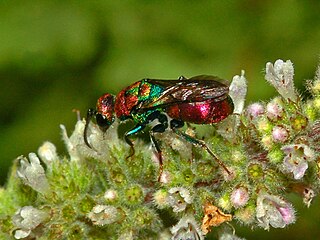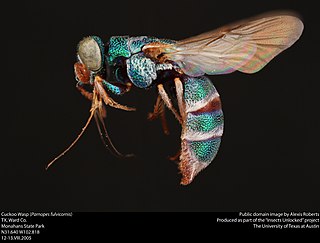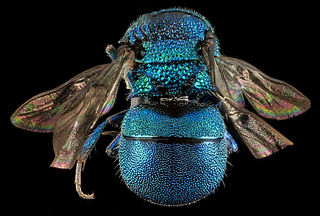
Commonly known as cuckoo wasps or emerald wasps, the hymenopteran family Chrysididae is a very large cosmopolitan group of parasitoid or kleptoparasitic wasps, often highly sculptured, with brilliant metallic colors created by structural coloration. They are most diverse in desert regions of the world, as they are typically associated with solitary bee and wasp species, which are also most diverse in such areas. Their brood parasitic lifestyle has led to the evolution of fascinating adaptations, including chemical mimicry of host odors by some species.

The subfamily Chrysidinae contains those species that are most commonly recognized as cuckoo wasps, being by far the largest and most familiar subfamily. The group contains 3000 species with 48 genera worldwide. They are highly sculptured, with brilliantly metallic-colored bodies, covering the entire spectrum, but primarily blues and greens.
The Euparagiinae are a small subfamily of rare wasps in the family Vespidae containing a single extant genus Euparagia. The group had a cosmopolitan distribution in past geological times extending back to the Early Cretaceous, but is now a geographically relict taxon known only from the desert regions of the Southwestern United States and northwestern Mexico.

Megalara garuda, colloquially referred to as the "King of Wasps", is a large wasp and the only species in the genus Megalara, family Crabronidae, tribe Larrini. The species M. garuda is only known from the Mekongga Mountains in the southeastern part of the Indonesian island of Sulawesi. It was described in 2012 by Lynn Kimsey, director of the Bohart Museum of Entomology and professor of entomology at the University of California, Davis, and Michael Ohl, curator and head of entomology at the Museum für Naturkunde, Berlin. Rosichon Ubaidillah from the Indonesian Institute of Sciences also contributed the discovery.
Lynn Kimsey is an entomologist, taxonomist, director of the Bohart Museum of Entomology and professor of entomology at the University of California, Davis since 1989. Her specialties are bees and wasps; and insect diversity.

The Bohart Museum of Entomology was founded in 1946 on the campus of the University of California, Davis. The museum is currently the seventh largest insect collection in North America with more than seven million specimens of terrestrial and freshwater arthropods. At least 90% of these holdings are insects. The collection is worldwide in scope with the Western Hemisphere, Indonesia, and Australasia particularly well represented.

Chrysis is a very large genus of cuckoo wasps. It is the largest genus in the family, including over 1,000 species in over 20 subgenera, as speciose as all remaining Chrysididae combined. The generic name is derived from Greek chrysis, "gold vessel, gold-embroidered dress", and pays tribute to the brilliant metallic appearance of wasps in the genus.

Hedychrum is a large genus of cuckoo wasps. With roughly 150 species, it is the second largest genus in the family; most species are from the Palaearctic, but they can be found in the Oriental, Afrotropical, Nearctic, and Neotropical regions. Their hosts are typically from the subfamily Philanthinae.
Chrysis provancheri is a species of cuckoo wasp in the family Chrysididae.

Parnopes is a genus of cuckoo wasps in the family Chrysididae. The known hosts are in the Crabronidae, subfamily Bembicinae..
Stigmus americanus is a species of aphid wasp in the family Crabronidae. It is found in North America.

Elampini is a tribe of cuckoo wasps in the family Chrysididae.

Chrysura simplex is a species of cuckoo wasps, insects in the family Chrysididae.

Amiseginae is a subfamily of cuckoo wasps in the family Chrysididae. There are more than 30 genera and 150 described species in Amiseginae. The group occurs worldwide, and they are parasitoids of stick insect eggs (Phasmatodea). Females of some genera are flightless and resemble ants.

Loboscelidiinae is a small subfamily of cuckoo wasps in the family Chrysididae. There are 2 genera and more than 40 described species in Loboscelidiinae, and they are parasitoids of walking stick eggs.
Elampus cecchiniae is a species of wasp in the cuckoo wasp family (Chrysididae). The species was first described in 1967 by A. P. Semenov-Tian-Shanskij as Notozus cecchiniae and transferred to the genus Elampus in 1991. The holotype is a male that was found in Turkmenistan.

Omalus is a genus of cuckoo wasps in the family Chrysididae.

Omalus aeneus is a species of cuckoo wasps belonging to the family Chrysididae.
Euparagia is a genus of wasps in the family Vespidae, the only extant genus in the subfamily Euparagiinae.

Parnopini is a small tribe of cuckoo wasps in the family Chrysididae. There are 3 genera and about 20 described species in Parnopini; only the hosts of one genus (Parnopes) are known, and they are in the Crabronidae.













